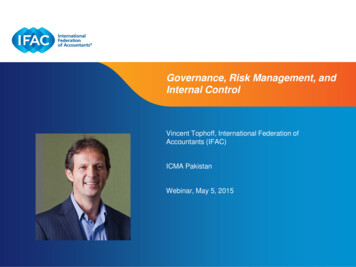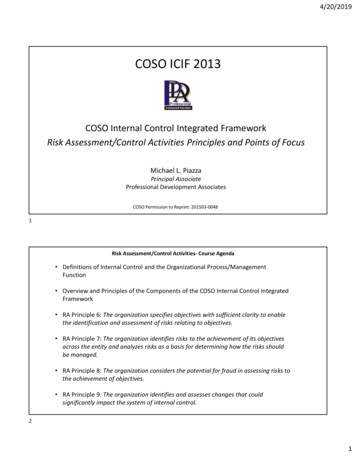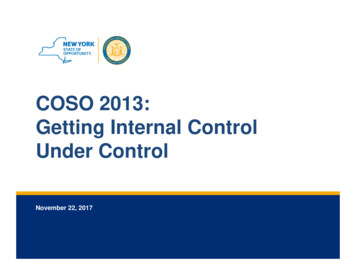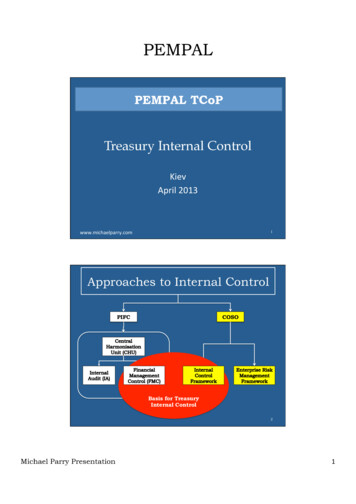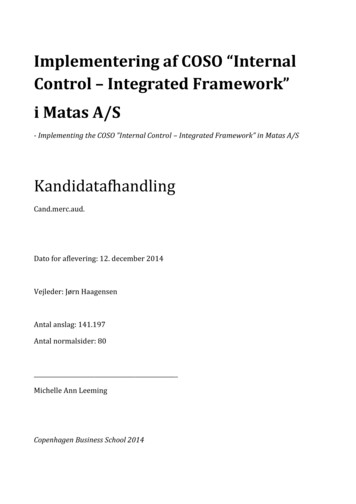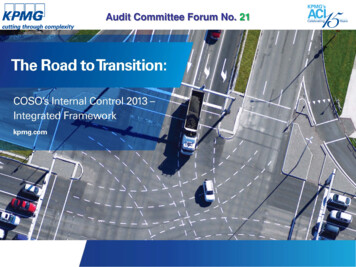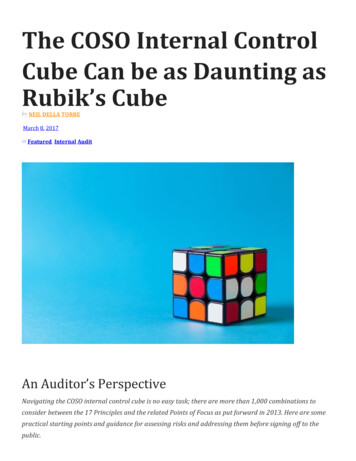
Transcription
The COSO Internal ControlCube Can be as Daunting asRubik’s Cubeby NEIL DELLA TORREMarch 8, 2017in Featured, Internal AuditAn Auditor’s PerspectiveNavigating the COSO internal control cube is no easy task; there are more than 1,000 combinations toconsider between the 17 Principles and the related Points of Focus as put forward in 2013. Here are somepractical starting points and guidance for assessing risks and addressing them before signing off to thepublic.
Those who sign and file internal control representation documents with regulators, such as the SEC, areoften guided by the Internal Control – Integrated Framework (or should be). This Framework is publishedby The Committee of Sponsoring Organizations of the Treadway Commission (COSO), which has amission to provide thought leadership through the development of comprehensive frameworks andguidance on enterprise risk management, internal control and fraud deterrence. Often thought of as theworld’s gold standard for internal control frameworks, the COSO Framework presents the dauntingchallenge of three dimensions to mix and match, similar to a Rubik’s Cube.The COSO Framework has an Executive Summary available to the public, which has a diagram of the cubeon page 6. Factoring in the Principles and related Points of Focus clarified in the 2013 version, the COSOcube has over a thousand possible combinations to consider. Therefore, identifying the main objectivesand then deciding where to start and how best to proceed is the key to proper utilization. A CPA withCOSO training, such as the COSO Internal Control Certificate Program can be a valuable partner.The Cube’s Sides and Their Practical Starting PointsThe top side of the cube has three internal control objectives: operation, reporting and compliance. Thisturn of the cube for an annual management assessment of the effectiveness of the Internal Controls overFinancial Reporting (ICFR) per SEC requirements should start with the External Financial Reportingobjective. A simple reason is that the public relies on public company external financial reports andexecutive officers, specifically the CEO and CFO (or equivalent), to certify that they have evaluated theeffectiveness of disclosure controls, which includes ICFR (i.e., the “signers”). This is not to diminish theimportance of operating objectives, which address performance goals and the safeguarding of assets.Also, compliance objectives pertaining to the adherence of laws and regulations certainly merit adequateattention.The right side of the cube addresses the hierarchy of an organization as descending from entity, division,operating unit, down to functions. Typically, the signer is an executive with clear visibility of theFramework’s relevant activities from the entity to operating unit levels. It is at the functional level wherevisibility often becomes unclear to the signer due to details, volume, and lack of time to address issues.Therefore, risk becomes more difficult to assess.Being an astute reader of a balance sheet and income statement, core reports in SEC reporting does notenable the executive to detect material ICFR deficiencies. Controls to prevent material errors pertainingto revenue recognition, inventory, fair valuations and capital vs. period cost, etc., generally occur at afunctional level within the control activities component and respective principles. Accordingly, this is agood side of the cube to start with.The front face side of the cube has five levels known as components: control environment, riskassessment, control activities, information & communications and monitoring activities. The second level,
which is not visible on the Framework’s cube, is the 17 Principles in support of the five components.Finally, on average, each Principle has 5 Points of Focus.For this final side of the cube, control activities is our starting point. This will be explained as weproceed and take the lead from the Public Company Accounting Oversight Board (PCAOB) Standardsfrom an external audit perspective.Words of CautionBefore going further, it is critically important to note that the cube’s objectives, organization levels,components and principles are all interconnected and interdependent. And if any one of the relevant 17Principles are not properly designed or operating effectively (respectively referred to by the Frameworkas “present” and “functioning”), the entire associated component cannot be present and functioning.Further, the Framework defines a “major deficiency” when the company cannot conclude a relevantPrinciple is present and functioning. When this happens, the company cannot conclude that it has met therequirements of an effective system of internal control, which is akin to a “material deficiency” as definedby the SEC and PCAOB. While starting with the Framework’s cube set on external financial reporting,function and control activity, it can be safely assumed that any deficiencies will lead to turning the cubeand exploring from a different but related paradigm to address the cause of the deficiencies. For example,control activity accounting internal control deficiencies are almost always related to control environmentweaknesses, such as competencies and accountabilities.How to Best ProceedWith a CPA versed in the COSO Framework as your partner, the best place to start with the cube turned toexternal financial reporting, function and control activity is the company’s trial balance.At first, the trial balance may seem to be just a list of numbers, often voluminous, in debit and creditformat. However, it represents the culmination of the economic activity of a reporting entity at a periodof time. The most basic financial reports showing the entity’s financial position (balance sheet) andresults of operations (income statement) are directly derived from the trial balance. Under each accountlisted are activities that capture the economic events from point of origination to understandablesummation. Many accounting firms refer to the trial balance as the “lead schedule,” as it leads up to thefinancials and down to the underlying activity.Management’s Reporting Assertions and Risk AssessmentWhen management asserts to the public that their entity’s financial statements are free of materialmisstatement and the ICFR is free of material deficiencies, this can only be based on an understanding ofthe assertions. Assertions are being made about accounts that could individually or collectively cause a
material misstatement, along with other requirements. The assertions as defined by PCAOB Standards AUSection 326 are:1. Existence or occurrence – Assets or liabilities of the company exist at a given date, and recordedtransactions have occurred during a given period.2. Completeness – All transactions and accounts that should be presented in the financial statementsare so included.3. Valuation or allocation – Asset, liability, equity, revenue and expense components have beenincluded in the financial statements at appropriate amounts.4. Rights and obligations – The company holds or controls rights to the assets, and liabilities areobligations of the company at a given date.5. Presentation and disclosure – The components of the financial statements are properly classified,described and disclosed.6. Cut-off is proper.An important logistical step to create order and reduce account volume to a practical level is to applythe assertions by accounts as grouped by related function and related control activities, in addition tofinancial statement order. For example: Revenue cycle grouping – revenue, accounts receivable, deferred revenue, bad debts. Procurement cycle – inventory, accounts payable, expenses. Contractual obligations – contracted services, leases, acquisitions. Human resources – compensation, benefits, taxes. Tax accounting – deferred assets, liabilities, expenses. General accounting – fixed assets, depreciation, accruals.An audit requirement is to gain an understanding of the entity’s internal controls, which is akin to “arethey present” in COSO Framework terms. The key is to identify those policies and procedures that containthe selected and developed control activities to mitigate the of a material reporting misstatement.This includes general information technology (IT) controls, as well as software application controls.Accordingly, the questions to ask for each identified functional account grouping are:1. What policies and procedures constitute a design that would preclude a material error fromoccurring in the normal course of business.2. Are they present?3. Are they functioning?
Some policies and procedures should be considered “must-have” for internal controls to be consideredadequate, such as credit checks. Others should be evaluated for cost benefit, for example manuallycancelling paid invoices.Referring to the PCAOB guidance again, each of the account groupings should be assessed for risk ofmaterial misstatement as the assertion level by management as follows: Inherent risk, which refers to the susceptibility of an assertion to a misstatement, due to error orfraud, that could be material, individually or in combination with other misstatements, beforeconsideration of any related controls. Control risk, which is the risk that a misstatement due to error or fraud that could occur in anassertion and that could be material, individually or in combination with other misstatements, willnot be prevented or detected on a timely basis by the company’s internal control. Control risk is afunction of the effectiveness of the design and operation of internal control, which, again, is akin to“present” and “functioning” per the Framework.Of course, if the design is not adequate, proceed with corrective action using the COSO Framework andSEC standards as the guide, along with the help of a CPA versed in both the Framework and SECregulations.ConclusionThe COSO Framework process is iterative, systemic and ongoing. The first turns of the cube – reporting,function and control activity – should get the process going in a positive direction. In the final analysis,the entire Framework cube should be turned and evaluated from every side, similar to the colorsmatching on Rubik’s cube. The mission is assessing risks across the entire cube and reacting until risksare reduced to a level deemed acceptably low in the judgment of management and those charged withgovernance before signing off to the public. BDG-CPAs. This is an article from the Governance Issues Newsletter, Volume 2017, Number 1, publishedon February 16, 2017. Use of the newsletter article constitutes acceptance of our Disclaimer and PrivacyPolicy.
The COSO Framework has an Executive Summary available to the public, which has a diagram of the cube on page 6. Factoring in the Principles and related Points of Focus clarified in the 2013 version, the COSO cube has over a thousand possible combinations to consider. Therefore, identifying the main objectives .


